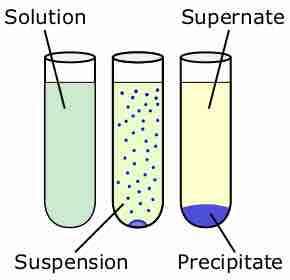Precipitation reactions are based on the interaction of antibodies and antigens. They are based on two soluble reactants that come together to make one insoluble product, the precipitate . These reactions depend on the formation of lattices (cross-links) when antigen and antibody exist in optimal proportions. Excess of either component reduces lattice formation and subsequent precipitation. Precipitation reactions differ from agglutination reactions in the size and solubility of the antigen and sensitivity. Antigens are soluble molecules and larger in size in precipitation reactions. There are several precipitation methods applied in clinical laboratory for the diagnosis of disease. These can be performed in semisolid media such as agar or agarose, or non-gel support media such as cellulose acetate.

Precipitation reaction
Difference in the visual appearance of an aggregate and a precipitate.
Precipitation methods include double immunodiffusion (qualitative gel technique that determines the relationship between antigen and antibody), radial immunodiffusion (semi-quantitation of proteins by gel diffusion using antibody incorporated in agar), and electroimmunodiffusion (variation of the double immunodiffusion method reaction that uses an electric current to enhance the mobility of the reactants toward each other). Precipitation reactions are less sensitive than agglutination reactions but remain gold standard serological techniques. The most commonly used serologic precipitation reactions are the Ouchterlony test (based on double immunodiffusion and named after the Swedish physician who invented it), and the Mancini method (based on single radial immunodiffusion). In the double immunodiffusion technique, three basic reaction patterns result from the relationship of antigens and antibodies. These patterns are identity, non-identity, and partial identity. The Mancini method results in precipitin ring formation on a thin agarose layer. The diameter of the ring correlates with the concentration of proteins in the precipitin.